
Niko McCarty
Founding Editor at Asimov Press
Science. Biology. Progress. Founding Editor @AsimovPress / Subscribe! Head of Creative @AsimovBio
Articles
-
1 week ago |
nmccarty.com | Niko McCarty
The FDA has approved lenacapavir, a twice-yearly injection that is nearly 100% effective at preventing HIV. I hate the name Yeztugo. More on this remarkable drug from Asimov Press and ‘Hard Drugs’ podcast. The problems with cancer screening, from Siddhartha Mukherjee. Chemical reactions affected by stir bars. A synthetic cell phage cycle.
-
1 week ago |
nmccarty.com | Niko McCarty
PandemicLLM, modeling the spread of diseases using text-based data. “The brain works at more than 10 bits per second.” (Apparently during movement.)Genetic tools to engineer Xenorhabdus griffiniae, a non-model bacterium that lives inside nematodes. Perturb-Multi merges “imaging with scRNA-seq for pooled CRISPR screens” in intact, mammalian tissue. The way a person breathes through their nose is enough to uniquely identify them, much like a fingerprint.
-
3 weeks ago |
nmccarty.com | Niko McCarty
Good writers should not fear AI. Many types of writing that people enjoy reading cannot easily be replicated by machines. Also, writing is a good way to think and you shouldn’t let machines think for you. Instead of trying to compete directly with AI models, then, the best writers will instead adapt and double down on the parts of writing that celebrate their humanness. Unfortunately, I know many good writers who fear AI models.
-
3 weeks ago |
nmccarty.com | Niko McCarty
Interview with Manu Prakash. The measles vaccine has saved >90 million lives in the last 50 years. Best paper I’ve seen in the last two weeks; mapping hundreds of proteins that bind to the human genome, with single amino acid resolution. An ancient protein fold works in both mirror-image forms; it has no ‘handedness.’ It can bind to both L- and D- forms of double-stranded DNA. NIAID is scrapping funds for “two major consortia” developing HIV vaccines.
-
4 weeks ago |
nmccarty.com | Niko McCarty
Arc Institute researchers recently published a preprint showing that their gene-editing technology, called Bridge recombinases, work in human cells. Many people applauded the paper on social media, while others asked, “Wait, how does this tool even work? And why does it matter?”Fair questions. The preprint is not easy to understand, and the reasonsfor inventing a new type of gene-editing tool in 2025 are even less obvious.
Try JournoFinder For Free
Search and contact over 1M+ journalist profiles, browse 100M+ articles, and unlock powerful PR tools.
Start Your 7-Day Free Trial →X (formerly Twitter)
- Followers
- 30K
- Tweets
- 2K
- DMs Open
- Yes